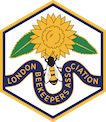
|
London Beekeepers' Association |

|
London Beekeepers' Association |
Aug in the Apiary[In the apiary, month by month.] Howard Nichols Although the calendar year commences in January many beekeepers view the new beekeeping year as commencing in August. The honey has been taken off and the beekeeper is now starting to prepare the bees for winter. The objective for August (and September) should be to put the bees in the best possible position to go into winter. If the honey has not yet been removed and it is now "ripe" then this should be the first job of the month. The empty, extracted, supers are then put above the crownboard for cleaning by the bees, then removed and fumigated. Preparing the colony for winterA significant risk to the colony in winter having too many varroa mites in the hive. The most common form of treatment at this time of year is a Thymol based product such as Apiguard. This needs to be in the colony for a minimum of 4 weeks and is most effective when the outside temperature is greater than 15°C. Early August is the optimum time to commence treatment as the honey has been removed and temperatures are still above 15°C. Other miticides are available. Apiguard has a high efficacy rate for killing mites but it does need to be administered properly to be effective. It is also a veterinary product and so it's essential to follow the application procedure strictly. Other winter preparations that may be dealt with in AugustSound and stable hive. Hives can be checked that they are on a stable and level surface. There should be no leaks or gaps as the hive must be waterproof and draught-proof to withstand the extremely testing conditions of winter. August is also a time of robbing by other bees as the nectar supply is scarce. Wasps may also be a nuisance and so there should not be any gaps in the woodwork where they may gain entry. There should only be one way into and out of a beehive. Strengthen colony with young bees. Worker bees produced from eggs laid in August and September need to live for up to 6 months rather than 6 weeks. A feed of weaker sugar syrup after the honey has been removed and a varroa treatment effectively completed will stimulate the queen into continuing her egg laying whereas, otherwise, she will be decreasing this activity. Other action to be taken this monthEntrance blocks. Use entrance blocks to help bees defend the colony against attacks from wasps and from robbing by other bees. Check food reserves. Check that bees still have sufficient food reserves after the honey has been removed. Unite. Uniting colonies where appropriate. A large colony has a better chance of coming through the winter months than 2 small ones. Beekeepers are often tempted to overwinter 2 smaller colonies with the view to having 2 honey producing colonies next year. This is sometimes a mistake. If you successfully artificially swarmed a colony then the artificial swarm and colony of origin can be reunited should you so wish. Alternatively, if both are large enough to overwinter then you may choose to leave and so increase your stock. Protect and store supers against wax moth. If you have the opportunity to put super frames in a deep freeze for 48 hours then this will kill all 4 stages of the Wax Moth lifecycle. Take care when removing the frames as they are very brittle until the wax reaches ambient room temperature again. Acetic acid may also be used but special care is required as it is corrosive. Burning of Sulphur strips is another method. These 3 methods may be summarised as follows:
My own viewpoint is that used brood combs should be burnt and that retention is not compatible with running a hygienic apiary. Conversely, super combs are an extremely valuable resource and the beekeeper should make every effort to look after these on behalf of the bees until next spring. |
©2025 London Beekeepers' Association |